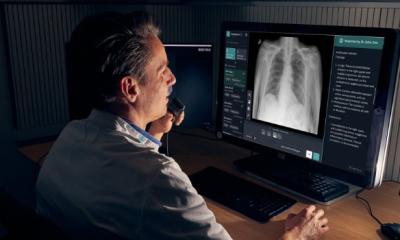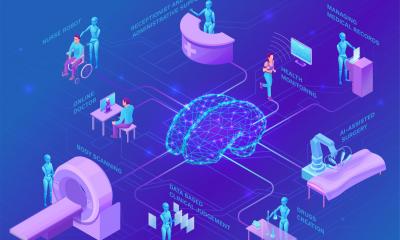Image source: Shutterstock/Panchenko Vladimir
Article • AI in clinical practice
Hospitals must think big, small and new
AI in healthcare has been a trending, sometimes head-spinning topic for a few years – and, with the COVID-19 pandemic, clinicians have been presented with a whole new range of AI products that may or may not meet their needs. When it comes to choosing one’s own set of tools, which criteria should prevail? A panel of European and US experts gave concrete examples of AI’s current implementation in clinical practise and shared tips on how to start working with AI from scratch during the online Healthcare Information and Management Systems Society (HIMSS) Conference.
Report: Mélisande Rouger

Diagnosis and triage have become two of the most interesting indications for AI deployment in clinical practice, according to a recent initiative by the NHSX, a joint unit from Nation Health Service (NHS) England and the Department of Health and Social Care. The organisation launched the AI in Health and Care Award (AI award) to support solutions addressing the strategic aims of the NHS across the whole development pathway, by funding AI tools with over £50 million to kick-start their deployment into the real word and research.
With an overwhelmingly positive response, the first selection of submitted projects spans a wide scope of applications, such as breast cancer screening and emergency stroke assessment, according to Indra Joshi, Director of AI for NHSX. ‘About 500 people applied and we selected 42 projects, ranging from image recognition that help recognise pathology, to how to triage images. In the UK, we’re experiencing a huge rise in the production of images that need triage, in the acute setting as well as in routine care. We’ve selected tools for triaging appointments, to help clinicians understand when to move patients to different wards in the hospital.’
The importance of thinking small

When talking about AI, people usually think big. AI’s ability to diagnose or treat is an important role, and much tackled by developers. But, one should also include ‘little AI’ in the equation. Utility functions such as voice recognition are often disregarded, but are widely used in clinical practice, and they deserve much more attention, Christopher Ross, Chief Information Officer for Mayo Clinic in Rochester, USA, explained. ‘One thing that’s unheralded is those small places where AI is being employed and helps make a difference – things like computer assisted coding, annotation and enrichment of text, so that we can enrich data to make it meaningful signals that can be used by others.’
Regarding AI for diagnosis, Ross’s team has developed algorithms to estimate kidney volume, an information obtained from radiological images that is used for a variety of therapeutic purposes. The Mayo Clinic has also published work on surveillance of patient populations for purposes of palliative care – notably to identify patients who are in decline or distress, and engage palliative care sooner and better.
The clinic’s work on AI near the bedside includes identifying atrial fibrillation by looking at an ECG when a patient is not experiencing an event. ‘It’s been tricky to identify people with rhythm problems if you’re not looking at them when they’re having that problem,’ he pointed out. ‘The ability to look at a normal ECG and predict from that whether someone has a rhythm problem is very promising.’ In total, the Mayo is using or developing about 200 AI products from discovery to bedside, in various disciplines including radiology, neurology, cardiology, gastroenterology.
Starting AI from scratch
Not every organisation needs to develop machine learning. It’s all about using the right tool for the right problem
Christopher Ross
Not every organisation has such capacities as the Mayo or NHS. Developing one’s own solutions is not a prerequisite for all institutions though. When thinking about AI, clinicians should rather look at a very important criterion: novelty. ‘We’re always looking at new technologies and don’t use only things we develop ourselves.’ Ross said.
For organisations more stretched for resources, a reasonable place to start is to determine which AI they can consume. ‘Can you prioritise where AI can really help? There might be areas where a simple “little AI” tool is all that’s needed. Not every organisation needs to develop machine learning. It’s all about using the right tool for the right problem,’ Ross observed. HC systems that want to start using AI should draw road maps to describe how to adopt technologies to prepare adequately, he advised.
The recent COVID-19 crisis has put a magnifying glass on how to implement AI in a low resource setting, Joshi explained. ‘At the peak of the epidemic, a number of companies came to sell their solutions,’ she said. ‘Commissions from other countries asked if we could give some guidance, with questions on what criteria do we need to consider and where would AI fit in.’
Joshi insisted on remembering basic principles, for example the IT structure and how AI solutions would fit in into an existing digital environment. ‘If you’re a digitally mature site and have a CIO, that’s great. But you don’t always do, and AI can be a totally foreign language. It’s important to break it down into different messages you need to think about – have a list of what you need to think about when you don’t know what you’re looking for.’
The NHSX published a Buyer's Guide to AI in Health and Care, to help clinicians select the appropriate solution with regards to their environment.
21.10.2020










